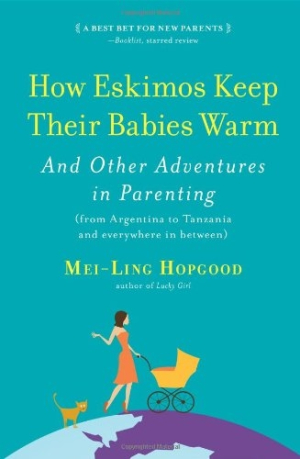How Eskimos Keep Their Babies Warm
Journalist Mei-Ling Hopgood’s book encourages thinking outside the Wonder bread version of US parenting. How Eskimos Keep Their Babies Warm (the baby is kept in a carrier made of animal hides, close to the mother’s body, and sometimes directly against the mother’s skin) is one woman’s account of her investigations into the parenting techniques of disparate cultures. Going beyond the obvious, Hopgood turns up information of special interest to new parents.
As one might expect, in Kenya, strollers are unaffordable and impractical and mothers simply have to do everything that they need to get done with their babies tied onto their backs. However, it is interesting and helpful to learn that newborns who are carried at least a few hours a day cry about half as much as babies who are not, and that the mothers who carry their babies produce more milk and are less likely to experience postpartum depression.
As with carrying, most of the parenting behaviors are the result of needs that become traditions. For example, among the Aka pygmies, who live in the forests along the border of the Congo and the Central African Republic, the men will allow their babies to suck their nipples (solely for the babies’ comfort, of course.) And the men split the daily childcare responsibilities with the mothers almost fifty-fifty. This level of paternal involvement, much higher than average in industrialized settings, is due to a combination of biological and environmental factors. The Aka’s cooperative hunting strategy is for the man to put out a net and for the woman to hide. The woman then emerges to scare passing prey into the net. Since the babies can’t stay home, they usually are carried by the man during the hunt. This is thought to be the starting point of a very close relationship between the infant and the father.
This kind of research demonstrates how adaptable babies and parents can be, and Hopgood describes her efforts to incorporate the beneficial aspects of behaviors she’s learned into her own parenting. In a conversational writing style, the author enriches her narrative with personal anecdotes, and with interviews with scientists and representatives from the various cultures she explores.
Reviewed by
Justin Courter
Disclosure: This article is not an endorsement, but a review. The publisher of this book provided free copies of the book to have their book reviewed by a professional reviewer. No fee was paid by the publisher for this review. Foreword Reviews only recommends books that we love. Foreword Magazine, Inc. is disclosing this in accordance with the Federal Trade Commission’s 16 CFR, Part 255.

